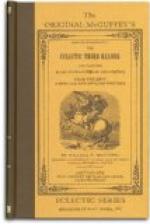Produced by Don Kostuch
[Transcriber’s Notes:
Welcome to the schoolroom of 1900. The moral tone is plain. “She is kind to the old blind man.”
The exercises are still suitable, and perhaps more helpful than some contemporary alternatives. Much is left to the teacher. Explanations given in the text are enough to get started teaching a child to read and write. Counting in Roman numerals is included as a bonus in the form of lesson numbers.
Each lesson begins with vocabulary words, followed by the description of a picture (if any) related to the lesson’s reading exercise. The lesson then consists of printed text for reading and sometimes script (handwriting) for reading or copying.
Don Kostuch
]
ECLECTIC EDUCATIONAL SERIES.
MCGUFFEY’S [Registered]
First
ECLECTIC READER
Revised Edition
McGuffey Edition and Colophon are Trademarks of
John Wiley & Sons, Inc.
New York — Chichester —
WEINHEIM — Brisbane — Singapore
— Toronto
Suggestions to teachers.
This First Reader may be used in teaching reading by any of the methods in common use; but it is especially adapted to the Phonic Method, the Word Method, or a combination of the two.
I. Phonic Method.—First teach the elementary sounds and their representative, the letters marked with diacriticals, as they occur in the lessons; then, the formation of words by the combination of these sounds. For instance, teach the pupil to identify the characters a, o, n, d, g, r, and th, in Lesson I, as the representatives of certain elementary sounds; then teach him to form the words at the head of the lesson, then other words, as nag, on, and, etc. Pursue a similar course in teaching the succeeding lessons. Having read a few lessons in this manner, begin to teach the names of the letters and the spelling of words, and require the groups, “a man,” “the man,” “a pen,” to be read as a good reader would pronounce single words.
II. When one of the letters in the combinations ou or ow, is marked in the words at the head of the reading exercises, the other is silent. If neither is marked, the two letters represent a diphthong. All other unmarked vowels in the vocabularies, when in combination, are silent letters. In slate or blackboard work, the silent letters may be canceled.
III. Word Method.—Teach the pupil to identify at sight the words placed at the head of the reading exercises, and to read these exercises without hesitation. Having read a few lessons, begin to teach the names of the letters and the spelling of words.




